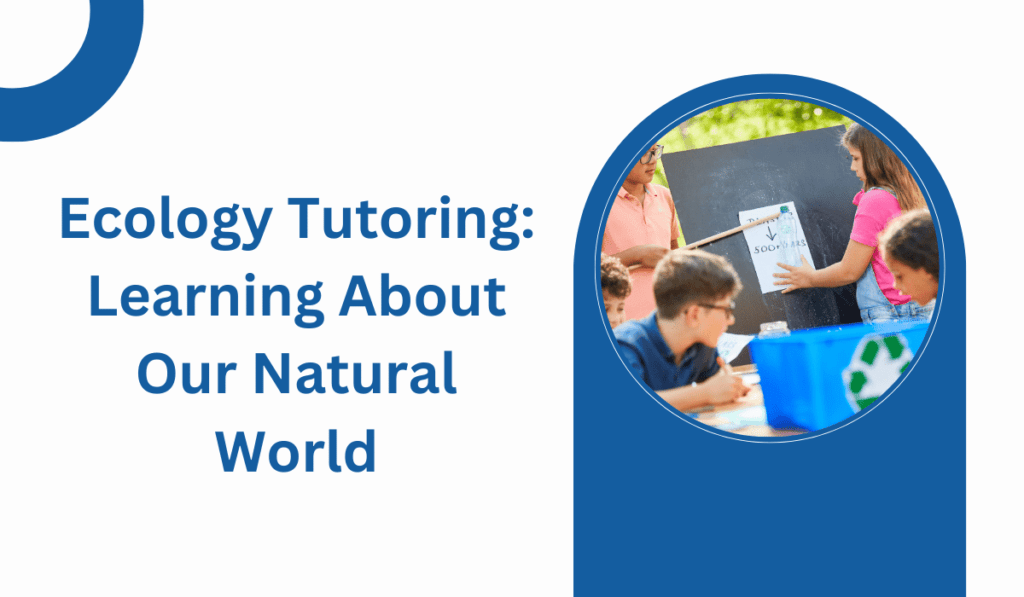Ecology examines how living organisms interact with their environment, revealing the complex web of life that sustains our planet. Ecology tutoring provides personalized support to help students understand these intricate relationships and the importance of our natural world. In this blog, we’ll explore the fundamentals of ecology, key topics in ecology tutoring, human impacts on the environment, and the advantages of tailored ecological education.
Understanding the Basics of Ecology
What is Ecology?
Ecology is the scientific study of how organisms interact with each other and their surroundings. It encompasses a wide range of topics, from the microscopic interactions between bacteria and their environment to the large-scale dynamics of entire ecosystems. Ecology can be broken down into several sub-disciplines, including:

- Population Ecology: Focuses on the dynamics of species populations and how they interact with the environment.
- Community Ecology: Examines the interactions between different species living in the same area.
- Ecosystem Ecology: Studies the flow of energy and nutrients through ecosystems.
- Conservation Ecology: Addresses the threats to biodiversity and develops strategies to protect species and their habitats.
Why Study Ecology?
Understanding ecology is crucial for several reasons:
- Biodiversity Conservation: It helps us protect and conserve diverse species and their habitats.
- Sustainable Resource Management: It guides us in using natural resources sustainably.
- Addressing Environmental Issues: It provides insights into solving environmental problems such as pollution and climate change.
- Understanding Human Impact: It helps us understand how our actions affect the environment and how we can mitigate negative impacts.
Overview of Ecology Tutoring
Ecology tutoring offers personalized lessons tailored to the student’s pace and level of understanding. Tutors can provide one-on-one attention, clarify difficult concepts, and help students prepare for exams and future careers in environmental science. Here are some key benefits of ecology tutoring:
- Customized Learning Plans: Tutors can develop personalized learning plans that cater to the student’s individual needs and learning style.
- Enhanced Engagement: Tutors can make learning more engaging by incorporating interactive activities and real-world examples.
- Immediate Feedback: Students receive immediate feedback on their work, helping them understand and correct their mistakes.
- Support and Encouragement: Tutors provide support and encouragement, helping students build confidence in their abilities.
Basic Concepts in Ecology
Ecosystems
An ecosystem consists of all the living organisms in a particular area, along with their physical environment. Ecosystems can be as small as a pond or as large as a forest. They are dynamic systems that constantly change in response to natural and human influences.
| Ecosystem Type | Examples |
|---|---|
| Terrestrial | Forests, grasslands, deserts |
| Aquatic | Lakes, rivers, oceans |
Biotic and Abiotic Components
- Biotic Components: These are the living parts of an ecosystem, such as plants, animals, and microorganisms. They play various roles, such as producers (plants), consumers (animals), and decomposers (bacteria and fungi).
- Abiotic Components: These include non-living elements like water, air, soil, and sunlight. They influence the types of organisms that can live in an ecosystem and how they interact.
Food Chains and Food Webs
- Food Chains: A linear sequence of organisms where each is eaten by the next. It begins with a primary producer (usually a plant) and ends with a top predator.
- Food Webs: A complex network of interconnected food chains. They illustrate the multiple feeding relationships in an ecosystem and show how energy and nutrients circulate.
Understanding these concepts is crucial for grasping how energy and nutrients flow through ecosystems. It also helps students appreciate the interdependence of organisms and the balance of natural systems.
Key Topics in Ecology Tutoring
Population Ecology
Population ecology studies the dynamics of species populations and how they interact with the environment. Key factors affecting population growth include birth rates, death rates, immigration, and emigration. Tutors can help students understand concepts like:
- Population Density: The number of individuals per unit area or volume.
- Carrying Capacity: The maximum population size that an environment can sustain.
- Growth Models: Exponential and logistic growth models that describe how populations change over time.
Community Ecology
Community ecology examines the interactions between different species living in the same area. Important interactions include:
- Predation: One organism hunts and eats another. It affects population sizes and the evolution of prey defenses.
- Competition: Organisms vie for the same resources, such as food, space, or mates. It can lead to the exclusion of one species or the division of resources.
- Mutualism: Both species benefit from the interaction, such as bees pollinating flowers.
- Commensalism: One species benefits while the other is neither helped nor harmed, like barnacles on a whale.
- Parasitism: One species benefits at the expense of the other, such as ticks feeding on mammals.
Ecosystem Ecology
Ecosystem ecology focuses on energy flow and nutrient cycling within ecosystems. It emphasizes the importance of biodiversity and the roles different species play in maintaining ecosystem health. Key concepts include:
- Primary Production: The production of organic compounds from carbon dioxide through photosynthesis.
- Trophic Levels: Different levels in a food web, including producers, primary consumers, secondary consumers, and decomposers.
- Biogeochemical Cycles: The cycles of nutrients like carbon, nitrogen, and phosphorus through ecosystems. These cycles involve the atmosphere, hydrosphere, lithosphere, and biosphere.
Conservation Ecology
Conservation ecology addresses the threats to biodiversity, such as habitat destruction and climate change. It develops strategies to protect species and their habitats. Topics include:
- Endangered Species: Species at risk of extinction and the factors contributing to their decline.
- Habitat Restoration: Efforts to restore damaged ecosystems to their natural state.
- Protected Areas: The establishment and management of national parks, wildlife reserves, and other protected areas.
- Conservation Genetics: The study of genetic diversity within species and its importance for their survival.
Human Impact on the Environment
Pollution
Pollution refers to the introduction of harmful substances into the environment. There are several types of pollution:
- Air Pollution: Emissions from vehicles and factories release pollutants like carbon monoxide, sulfur dioxide, and particulate matter into the atmosphere. These pollutants can cause respiratory problems, contribute to acid rain, and exacerbate climate change.
- Water Pollution: Contaminants in rivers, lakes, and oceans come from industrial waste, sewage, agricultural runoff, and plastic debris. Water pollution can lead to the death of aquatic organisms, the spread of waterborne diseases, and the disruption of marine ecosystems.
- Soil Pollution: Chemicals and waste in the soil come from pesticides, industrial waste, and improper disposal of hazardous materials. Soil pollution can reduce soil fertility, contaminate crops, and harm soil organisms.
| Type of Pollution | Sources | Effects |
|---|---|---|
| Air | Vehicle emissions, factories | Respiratory problems, acid rain, climate change |
| Water | Industrial waste, sewage, plastic debris | Waterborne diseases, harm to aquatic life, ecosystem disruption |
| Soil | Pesticides, industrial waste | Reduced soil fertility, contamination of crops, harm to soil organisms |
Climate Change
Climate change is driven by increased greenhouse gas emissions, primarily from the burning of fossil fuels and deforestation. Its effects include:
- Rising Temperatures: Global warming leads to more frequent and intense heatwaves, affecting both ecosystems and human health.
- Melting Ice Caps: The loss of polar ice contributes to rising sea levels, which can inundate coastal areas and displace human populations.
- Extreme Weather: More frequent and severe weather events, such as hurricanes, droughts, and floods, threaten both natural and human systems.
- Ocean Acidification: Increased carbon dioxide levels lead to the acidification of oceans, harming marine life, particularly shell-forming organisms like corals and mollusks.
Habitat Destruction
Human activities like deforestation, urbanization, and agriculture destroy natural habitats, threatening wildlife. Habitat destruction leads to:
- Loss of Biodiversity: The extinction of species and the decline of ecosystem services.
- Fragmentation: Breaking up of habitats into smaller, isolated patches, making it difficult for species to migrate and find resources.
- Degradation: The reduction in the quality of habitats, affecting the health and survival of species.
| Activity | Impact on Habitat |
|---|---|
| Deforestation | Loss of forests, reduced biodiversity |
| Urbanization | Fragmentation and degradation of natural areas |
| Agriculture | Conversion of natural habitats to farmland, pesticide pollution |
Methods and Tools in Ecology
Field Studies
Field studies involve collecting data directly from natural environments. Techniques include:
- Sampling: Collecting samples of soil, water, or organisms to analyze their characteristics and distributions.
- Observation: Watching and recording behaviors of species to understand their interactions and adaptations.
- Transects and Quadrats: Using systematic methods to study the distribution and abundance of species across different habitats.
Field studies provide valuable insights into the real-world dynamics of ecosystems and the factors influencing them.
Laboratory Studies
Laboratory studies allow for controlled experiments and detailed analysis of ecological data. Techniques include:
- Microcosms: Small-scale experimental systems that replicate the conditions of natural ecosystems.
- Genetic Analysis: Studying the DNA of organisms to understand their genetic diversity, evolutionary relationships, and adaptations.
- Chemical Analysis: Measuring the concentrations of nutrients, pollutants, and other substances in samples from the field.
Laboratory studies complement field research by allowing scientists to isolate variables and test hypotheses under controlled conditions.
Modeling and Simulation
Ecological models simulate complex interactions within ecosystems. They help predict the impacts of environmental changes and guide conservation efforts. Types of models include:
- Population Models: Simulate the growth and dynamics of species populations under different conditions.
- Ecosystem Models: Represent the flow of energy and nutrients through ecosystems, incorporating multiple trophic levels and interactions.
- Climate Models: Predict the effects of climate change on ecosystems and species distributions.
Models are powerful tools for understanding and managing ecological systems, as they can integrate large amounts of data and provide insights into future scenarios.
Benefits of Ecology Tutoring
Personalized Learning
Ecology tutoring provides tailored lessons that match the student’s learning pace and style. Tutors can focus on areas where the student needs the most help, ensuring a thorough understanding of key concepts. Personalized learning can include:
- Customized Lesson Plans: Based on the student’s strengths, weaknesses, and interests.
- Flexible Scheduling: Lessons can be scheduled at times that are convenient for the student.
- Adaptable Teaching Methods: Tutors can use various teaching methods, such as visual aids, interactive activities, and practical examples, to enhance understanding.
Enhanced Understanding
Tutoring offers in-depth exploration of ecological topics, fostering critical thinking and problem-solving skills. Students can engage in discussions, ask questions, and receive immediate feedback. This deeper understanding can lead to:
- Improved Academic Performance: Better grades in ecology courses and exams.
- Increased Engagement: Greater interest and motivation in learning about the natural world.
- Critical Thinking Skills: The ability to analyze complex problems and develop solutions based on evidence.
Preparation for Exams and Careers
Tutors help students prepare for exams by reviewing important topics, practicing problem-solving techniques, and providing test-taking strategies. Additionally, they offer guidance on pursuing careers in ecology and environmental science. This preparation can include:
- Review Sessions: Focused reviews of key concepts and topics likely to appear on exams.
- Practice Exams: Simulated exams to help students become familiar with the format and time constraints.
- Career Advice: Information on potential career paths, required qualifications, and job opportunities in ecology and related fields.
Conclusion
Ecology is a fascinating field that reveals the intricate connections between living organisms and their environment. Through personalized ecology tutoring, students can gain a deeper understanding of these connections and their significance. By learning about ecosystems, population dynamics, and human impacts on the environment, students are better equipped to contribute to the conservation and sustainable management of our natural world.
For more information on ecology tutoring and other educational resources, visit Tutor Linkers. Explore our blog for additional articles on environmental science and related topics.
External Resources:
- National Geographic – Ecology
- Environmental Protection Agency – Ecosystems
- Smithsonian Institution – Biodiversity
- World Wildlife Fund – Conservation
- Nature Conservancy – Climate Change
This blog is a great starting point for anyone interested in learning more about ecology and the benefits of personalized tutoring in this essential field. Whether you’re a student looking to improve your understanding of ecological concepts, a parent seeking support for your child’s education, or an adult learner interested in environmental science, ecology tutoring can provide the guidance and knowledge you need.
Exploring Further: Advanced Topics in Ecology
Landscape Ecology
Landscape ecology focuses on the spatial patterns and processes within landscapes. It examines how these patterns influence the abundance and distribution of organisms. Key topics include:
- Patch Dynamics: The study of how different habitat patches change over time.
- Corridors and Connectivity: How landscape features facilitate or impede the movement of organisms.
- Human Impact: How land use changes, such as agriculture and urbanization, alter landscapes and affect biodiversity.
Urban Ecology
Urban ecology studies the interactions between living organisms and their urban environment. It addresses issues such as:
- Green Spaces: The role of parks, gardens, and other green areas in supporting urban biodiversity.
- Pollution and Waste: The impact of urban pollution and waste on local ecosystems.
- Human-Wildlife Interactions: How urbanization affects wildlife behavior and human-wildlife conflicts.
Global Ecology
Global ecology examines ecological processes at the planetary scale. It looks at how local and regional ecological processes contribute to global patterns. Topics include:
- Biogeography: The study of the distribution of species and ecosystems around the world.
- Global Carbon Cycle: How carbon is cycled through the atmosphere, oceans, and land, and its role in climate regulation.
- Global Biodiversity Hotspots: Areas of high biodiversity that are under threat and the efforts to protect them.
The Role of Technology in Ecology
Remote Sensing
Remote sensing involves the use of satellites and aircraft to collect data about the Earth’s surface. It is used in ecology to:
- Monitor Land Use Changes: Detect deforestation, urbanization, and other land use changes.
- Track Wildlife Movements: Follow the migration patterns and habitat use of animals.
- Assess Ecosystem Health: Evaluate the health of forests, wetlands, and other ecosystems.
Geographic Information Systems (GIS)
GIS is a powerful tool for analyzing spatial data. In ecology, it is used to:
- Map Species Distributions: Create maps showing where different species are found.
- Model Habitat Suitability: Predict the suitability of different areas for various species.
- Analyze Landscape Patterns: Study the arrangement and connectivity of different habitats.
Environmental DNA (eDNA)
Environmental DNA involves collecting DNA from environmental samples, such as water or soil, to detect the presence of organisms. It is used to:
- Monitor Biodiversity: Identify the species present in an area without needing to capture or observe them directly.
- Detect Invasive Species: Early detection of invasive species before they become established.
- Assess Ecosystem Health: Monitor changes in biodiversity as an indicator of ecosystem health.
Case Studies in Ecology
The Reintroduction of Wolves to Yellowstone National Park
The reintroduction of wolves to Yellowstone in the 1990s is a famous example of how keystone species can shape ecosystems. Wolves helped control the population of deer, which allowed vegetation to recover and benefitted other species.
Coral Reef Restoration
Coral reefs are some of the most biodiverse ecosystems on the planet, but they are threatened by climate change, pollution, and overfishing. Efforts to restore coral reefs include growing corals in nurseries and transplanting them to damaged reefs.
Urban Biodiversity Initiatives
Cities around the world are implementing initiatives to promote urban biodiversity. These include creating green roofs, establishing urban wildlife corridors, and enhancing public parks to support native species.
Future Directions in Ecology
Integrating Social Sciences
Ecology is increasingly recognizing the importance of integrating social sciences to address environmental issues. Understanding human behavior, economics, and politics is crucial for effective conservation and resource management.
Climate Change Adaptation
As climate change impacts become more severe, ecologists are focusing on helping species and ecosystems adapt. This includes developing strategies for assisted migration, habitat restoration, and building resilience in ecosystems.
Advances in Technology
Technological advancements continue to revolutionize ecology. Drones, artificial intelligence, and big data analytics are opening new possibilities for research and conservation.
In conclusion, ecology is a dynamic and interdisciplinary field that offers insights into the complex interactions that sustain life on Earth. Personalized ecology tutoring can help students navigate this fascinating subject, preparing them for academic success and future careers in environmental science. By understanding and addressing the ecological challenges we face, we can work towards a more sustainable and resilient world.
For more information on ecology tutoring and other educational resources, visit Tutor Linkers. Explore our blog for additional articles on environmental science and related topics.
External Resources:
- National Geographic – Ecology
- Environmental Protection Agency – Ecosystems
- Smithsonian Institution – Biodiversity
- World Wildlife Fund – Conservation
- Nature Conservancy – Climate Change
This blog is a comprehensive guide for anyone interested in learning more about ecology and the benefits of personalized tutoring in this essential field. Whether you’re a student looking to improve your understanding of ecological concepts, a parent seeking support for your child’s education, or an adult learner interested in environmental science, ecology tutoring can provide the guidance and knowledge you need.




